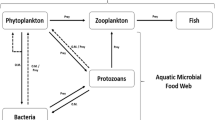Abstract
Chlorella sorokiniana was cultured in heterotrophic or mixotrophic mode in outdoor enclosed tubular photobioreactor. The culture temperature was maintained at 32–35 °C. At night, theChlorella culture grew heterotrophically, and 0.1 M glucose was completely consumed. The biomass growth yield of glucose was 0.35 ± 0.001 g-biomass g-glucose−1. During the day, the algal culture grew mixotrophically and the biomass growth yield was 0.49 g-biomass g-glucose−1 in low density culture (initial biomass concentration, Xo = 2 g l−1), 0.56 g-biomass g-glucose−1 in medium density culture (Xo = 4 g l−1) and 0.46 g-biomass g-glucose−1 in high density culture (Xo = 7 g l−1). The daily area productivity of the culture, with Xo = 4 g l−1 corresponded to 127 g-biomass m−2 d−1 during the day and 79 g-biomass m−2 d−1 during the night. In all the cultures, the dissolved O2 concentration increased in the morning, reached the maximum value at noon, and then decreased in the afternoon. The dissolved CO2 concentration remained at 3 mBar in the morning and increased in the afternoon. Glycolate was not found to accumulate in culture medium.
Similar content being viewed by others
References
Atkinson B, Mavituna F (1983) Biochemical Engineering and Biotechnology Handbook Chapter 3. The Nature, New York, 114–203.
Babel W, Muller RH (1985) Mixed substrate utilization in microorganisms: biochemical aspects and energetics. J. gen. Microbiol. 131: 39–45.
Ben-Amotz A, Katz A, Avron M (1982) Accumulation of β-carotene in halotolerant algae: purification and characterization of β-carotene-rich globules fromDunaliella bardawil (Chlorophyceae). J. Phycol. 18: 529–537.
Calkins VP (1943) Microdetermination of glycolic and oxalic acids. Ind. Engng. Chem. Anal. Ed. 15: 762–763.
Chaumont D (1993) Biotechnology of algal biomass production: a review of systems for outdoor mass culture. J. appl. Phycol. 5: 593–604.
Droop MR (1974) Heterotrophy of carbon. In Stewart WDP (ed.), Algal Physiology and Biochemistry. Blackwell, Oxford, 530–559.
Endo H, Sansawa H, Nakajima K (1977) Studies onChlorella regularis heterotrophic fast growing strain. II. Mixotrophic growth in relation to light intensity and acetate concentration. Plant Cell Physiol. 18: 199–205.
Gudin C (1978) Procede et dispositif pour le developpement et la culture de matieres photosynthetiques en suspensiondans un milieu aquatique. Brevet. francais 2361060.
Haass D, Tanner W (1974) Regulation of hexose transport inChlorella vulgaris. Plant Physiol. 53: 14–20.
Heijnen JJ, Roels JA (1981) A macroscopic model describing yield and maintenance relationships in aerobic fermentation. Biotechnol. Bioengng. 23: 739–745.
Kamiya A, Kowallik W (1987) Photoinhibition of glucose uptake inChlorella. Plant Cell Physiol. 28: 611–619.
Lalucat J, Imperial J, Pares R (1984) Utilization of light for the assimilation of organic matter inChlorella sp. VJ 79. Biotechnol. Bioengng. 26: 677–681.
Lee YK (1986) Enclosed bioreactors for the mass cultivation of photosynthetic organisms: the future trend. Trends in Biotechnol. 4: 186–189.
Lee YK, Low CS (1991) Effect of photobioreactor inclination on the biomass productivity of an outdoor algal culture. Biotechnol. Bioengng. 38: 995–1000.
Lee YK, Low CS (1992) Productivity of outdoor algal cultures in enclosed tubular photobioreactor. Biotechnol. Bioengng. 40: 1119–1122.
Lee YK, Pirt SJ (1981) Energetic of photosynthetic algal growth: Influence of intermittent illumination in short (40s) cycles. J. gen. Microbiol. 124: 43–52.
Lee YK, Soh CW (1991) Accumulation of astaxanthin inHaematococcus lacustris (Chlorophyta). J. Phycol. 27: 575–577.
Linton JD, Stephenson RJ (1978) A preliminary study on growth yield in relation to the carbon and energy content of various organic growth substrates. FEMS Microbiol. Lett. 3: 95–98.
Martinez F, Orus MI (1991) Interactions between glucose and inorganic carbon metabolism inChlorella vulgaris strain UAM 101. Plant Physiol. 95: 1150–1155.
Ogawa T, Aiba S (1981) Bioenergetic analysis of mixotrophic growth inChlorella vulgaris andScenedesmus acutus. Biotechnol. Bioengng. 23: 1121–1132.
Running JA, Huss RJ, Olson PT (1994) Heterotrophic production of ascobic acid by microalgae. J. Appl. Phycol. 6: 99–104.
Sauer N (1986) Hexose transport deficient mutants ofChlorella vulgaris. Arch. Microbiol. 132: 329–332.
Author information
Authors and Affiliations
Rights and permissions
About this article
Cite this article
Lee, YK., Ding, SY., Hoe, CH. et al. Mixotrophic growth ofChlorella sorokiniana in outdoor enclosed photobioreactor. J Appl Phycol 8, 163–169 (1996). https://doi.org/10.1007/BF02186320
Received:
Revised:
Accepted:
Issue Date:
DOI: https://doi.org/10.1007/BF02186320




